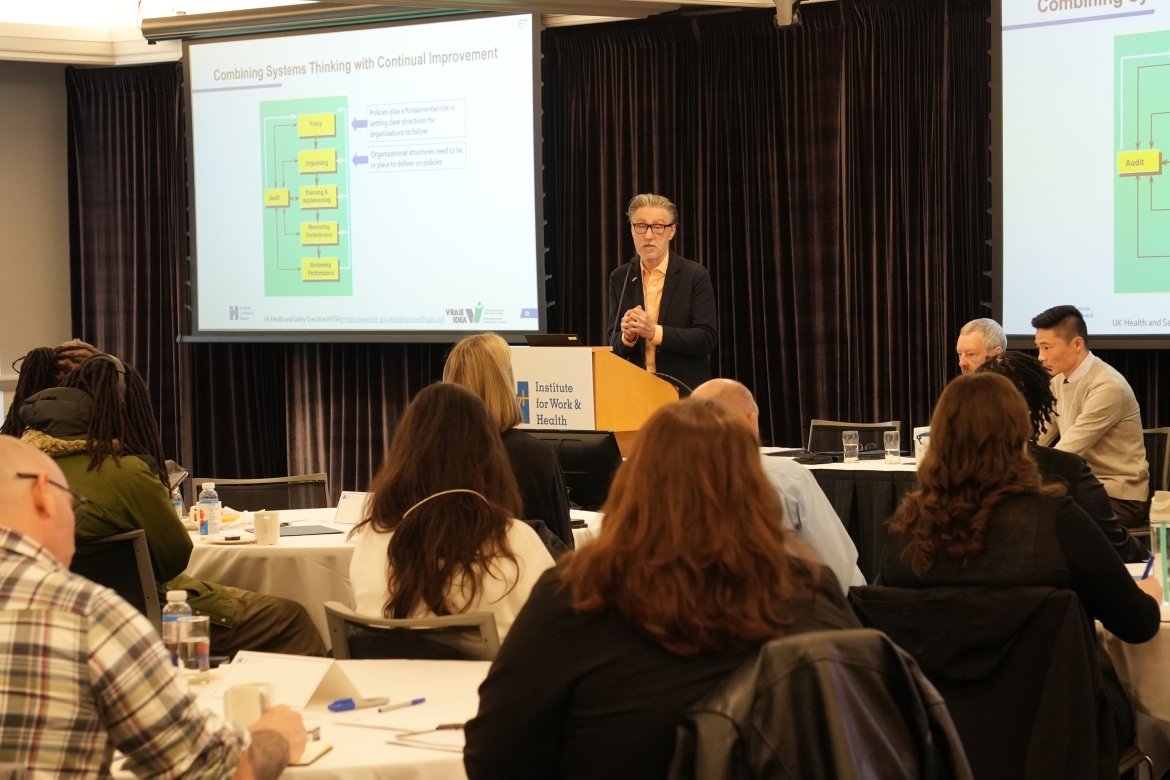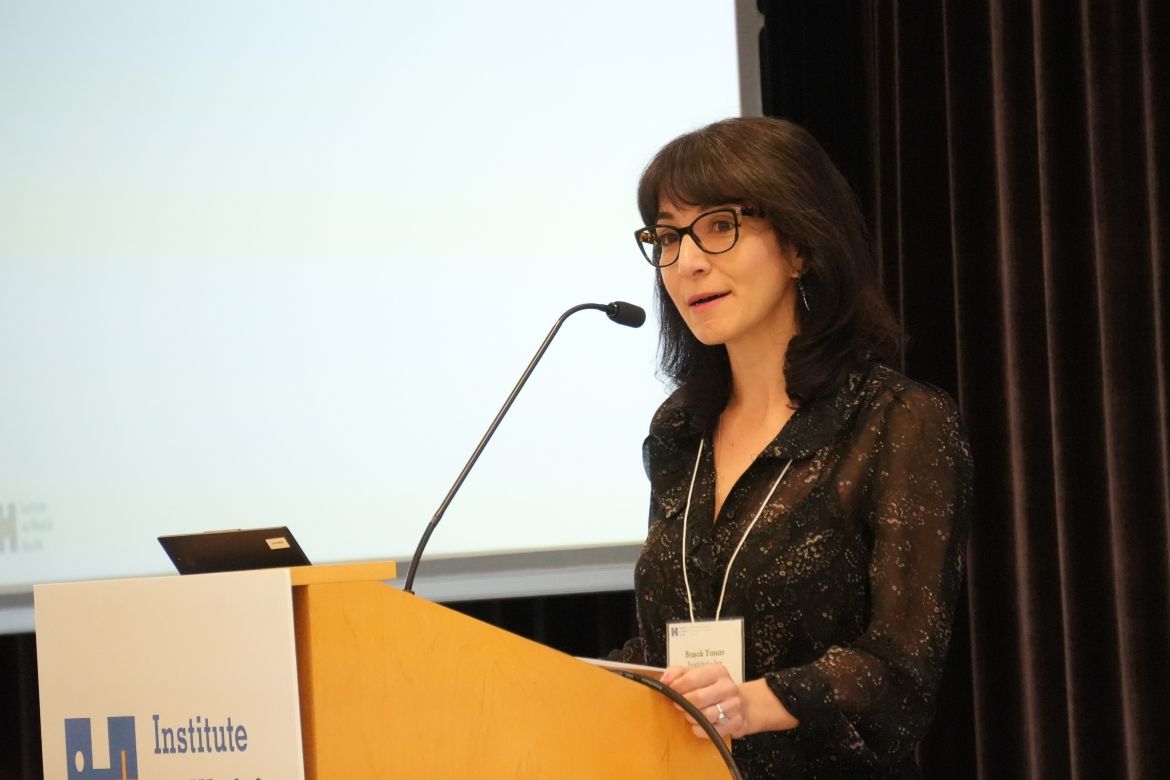One of the Institute for Work and Health’s (IWH) strategic directions is to broaden the reach and impact of IWH research. To that end, IWH hosted its second annual IWH Connects meeting in April.
IWH is committed to delivering research that responds to the needs of workers, workplaces and policy-makers,
said Morgan Lay, IWH director of strategic relations, in her opening remarks. With over 30 years behind us, we still think the best way to do this is creating a shared space for exchanging ideas,
Launched in 2024, IWH Connects is a network of leaders in evidenced-based approaches to creating healthy, safe and inclusive work environments, who gather to learn about IWH research and share their own perspectives on work and health issues.
Often, the people who are on the ground and trying to use research have more insights to give us than we have to give them in terms of how things actually are in the workplace,
noted Dr. Peter Smith, IWH president and senior scientist. In hosting this network, he added, we hope to identify emerging practice and policy gaps and issues that can be addressed or positively contributed to by research.
Attendees learned about research and resources for organizations in three key areas: building employer confidence in disability, equity, inclusion and accessibility (DEIA) practices; promoting health and safety in linguistically diverse workplaces; and addressing the psychosocial work environment. The resources shared by presenters are outlined below.
Building employer confidence in DEIA
The first topic was presented by researchers involved in the Inclusive Design for Employment Accessibility (IDEA) initiative: Dr. Emile Tompa, IWH senior scientist and IDEA executive director, and Alec Farquhar and W. Francis Fung, IDEA engagement co-leads. They discussed IDEA’s overarching goal of helping organizations to build up their disability confidence
—that is, ability to support workers with disabilities, through DEIA practices.

A lot of effort in the past may have been put into skilling up workers and getting them job-ready. But oftentimes they struggle to find employment because many employers lack the confidence on how best to tap into the talent pool of persons with disabilities,
says Tompa.
In service of their mission, IDEA is developing a pulse check questionnaire that organizations can use to gauge employees’ perspectives of their workplace’s inclusive practices, in nine domains. The domains are based on research by IDEA on which areas should be addressed at the organizational level (from information and communication technology, to procurement, to emergency preparedness). The results of the questionnaire can be used to identify areas where an organization is doing well or may need improvement.
Promoting health and safety in linguistically diverse workplaces
The second topic was presented by Dr. Basak Yanar, IWH scientist. Yanar described findings from a study on employers’ experiences integrating newcomers to Canada and implementing health and safety practices in linguistically diverse workplaces. Linguistic diversity influences how people communicate with an organization and whether they understand occupational health and safety information,
says Yanar. It also intersects with other diverse worker characteristics such as race, gender, ethnicity, culture and social class that influence interpersonal relationships within an organization.

Employers interviewed for this study provided a range of experiences and tactics they’ve taken to overcome language challenges—from using translation apps to using visuals or videos instead of written material for training.
From this study’s findings, Yanar’s research team will provide employers with summary that will include considerations for making occupational health and safety training information accessible, improve day-to-day workplace communication and build trust and psychological safety among workers.
Addressing the psychosocial work environment
The third topic, the psychosocial work environment, was presented by Dr. Peter Smith, IWH president and senior scientist. The psychosocial work environment, broadly, describes whether working conditions support worker wellbeing, productivity and positive experiences. Smith described that when aspects of the psychosocial work environment are positive—where a worker has supportive social connections and feels a sense of accomplishment—work can have positive metal health impacts. But negative aspects—where a worker fears injury on the job or faces harassment—can be mental health hazards.
Based on existing research, he notes the importance of both leadership commitment and worker engagement when designing approaches to address the psychosocial environment in the workplace. When we think about where to intervene, modifying the work environment and work processes is going to be more effective than modifying individuals or treating health conditions as they arise,
says Smith.
To assess the psychological work environment, Smith pointed to two tools that could be considered by employers to identify any issues in their workplace and measure the progress of interventions they may use to address them. The first is the Copenhagen Psychosocial Questionnaire, which asks more than 60 questions about 24 different dimensions of the psychosocial work environment. The Occupational Health Clinics for Ontario Workers (OHCOW)’s StressAssess is an accessible tool based on this survey, that is easy for workplaces to use. A second, shorter tool is the PSC-12, which consists of 12 questions focused on 4 domains. Results from either of these tools can help a workplace identify areas that could be improved upon in their organization.
Concluding thoughts
Summarizing the day, Smith reflected on the valuable opportunity for a two-way exchange. With so much information out there on workplace health and safety, it can be hard for organizations to sift through it all,
says Smith. We’re happy that we have this chance to share actionable, evidence-based insights, tools and resources with the leaders at IWH Connects. We also heard great feedback about where we can provide more information and research to help organizations with their health and safety practices.
To stay in the loop about when study findings are published, or when tools now in development are available, subscribe to our monthly newsletter.